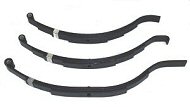REPLACING LEAF SPRINGS ON A TRAILER

Trailer Leaf Springs
One of the major components of a trailer’s running gear is the leaf spring. These provide an inexpensive and effective method of cushioning the ride of a trailer, thus protecting the cargo on a trailer from the shock of rough road surfaces. The springs also protect the rest of the running gear e.g. axles from damage. Occasionally, springs will need to be replaced prematurely due to hitting a pothole or in the case of a boat trailer, excessive corrosion.
In a leaf spring system, the springs are mounted to the frame-mounted hanger (or shackles) with a bushing and fluted shackle bolts. The axle in this system is fastened to the leaf springs with u-bolts (called a tie plate kit).
In recent years, some trailer manufactures have added the newer Torsion Axle to their line-ups as an option. The cushioning function is “built-in” to the axle and this precludes the need for leaf springs. However, you will find that most trailers on the road today have the leaf spring design.
There are several components that make up a leaf spring; the leaves, center-pin, straps and eyes. The number of leaves, the width, thickness and the heat treatment of the leaves all can affect the Load Rating of the spring. The springs have a load rating from the manufacturer and matching this to your trailer is a primary concern when replacing springs. Typically, we recommend that you replace your springs with the same part that was originally on the trailer so that it matches the rest of the running gear components like axles, coupler, brakes and tires / rims. Also, we recommend replacing both springs on an axle even if only one is damaged.
Many trailer manufacturers recommend that the springs be replaced approximately every five years as part of the maintenance plan.
There are several types of leaf springs used on trailers. The double eye spring is unique in that it mounts to the spring hangers using a pair of shackle links. Measuring this spring for replacement is to measure a straight line from the center of the front eye to the center of the rear eye. This measurement can be done on the trailer.
The Open Eye Slipper design uses a special hanger that allows it to flex. This system does not use shackle links. It is also measured on the trailer from the center of the front eye to the center of the rear shackle bolt
The Hook-End Slipper spring is measured on the trailer from the center of the front eye to the middle of the rear spring hanger.
The Radius End Slipper and the Flat End Slipper are both measured on the trailer from the center of the front eye to the end of the spring
Boat trailers face the same road hazards as utility trailers plus the corrosion that is caused by immersion in water, especially salt water. Several attempts have been made to design springs that will not corrode but these have met mixed reviews.
In salt water, salt crystals work their way between the leaves, causing corrosion from the inside out. The best way to prevent this from happening is to rinse the springs in fresh water immediately after immersion in salt water. Also, the best treatment to prevent corrosion is to use a product like CRC Marine Corrosion Inhibitor. This is a spray that will deposit a wax-like substance on the springs, inhibiting water and salt crystals from spring leaves.
We have about 80 different sizes and styles and it isn’t often that we cannot fill a customer’s needs for new replacement leaf springs and accessories at the Trailer Parts Superstore. Check out our complete Leaf Spring selection online at: TRAILER LEAF SPRINGS